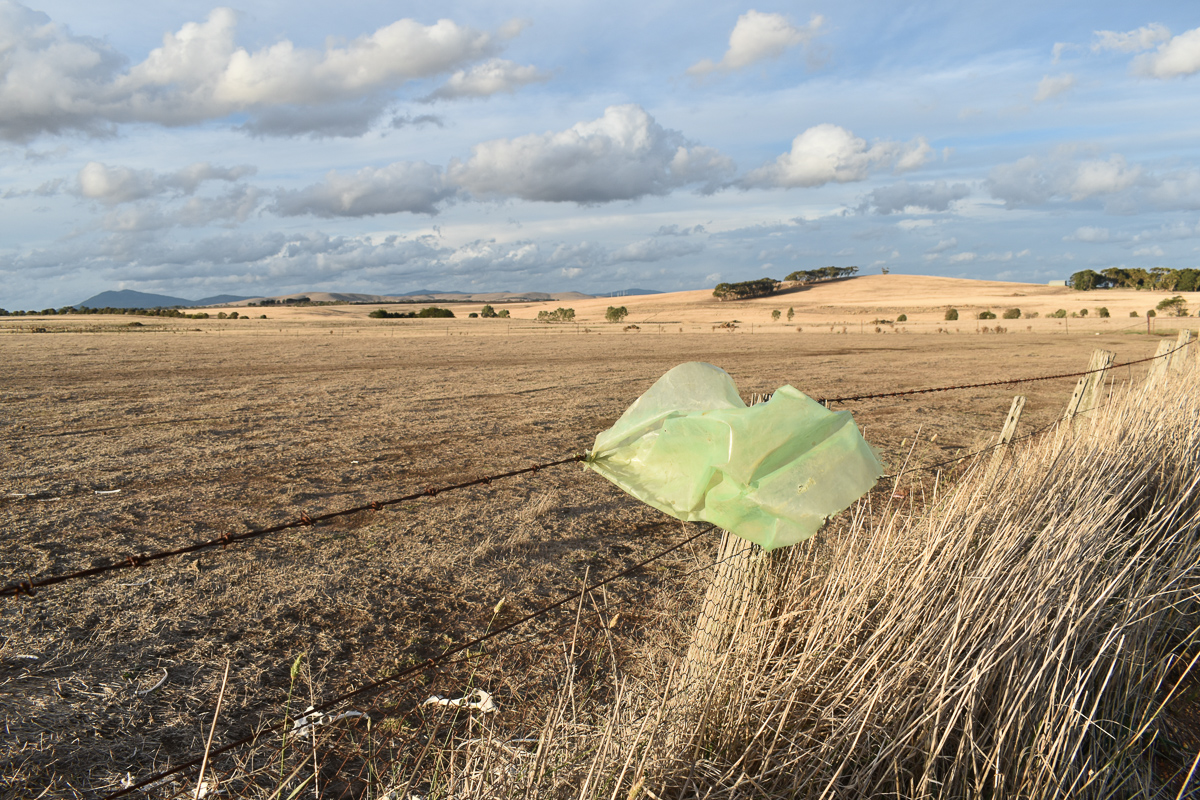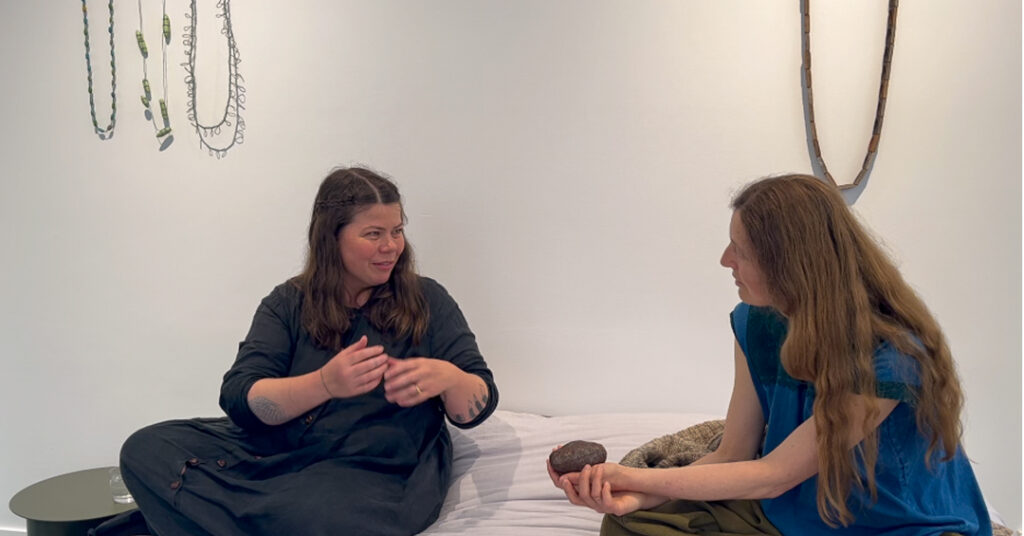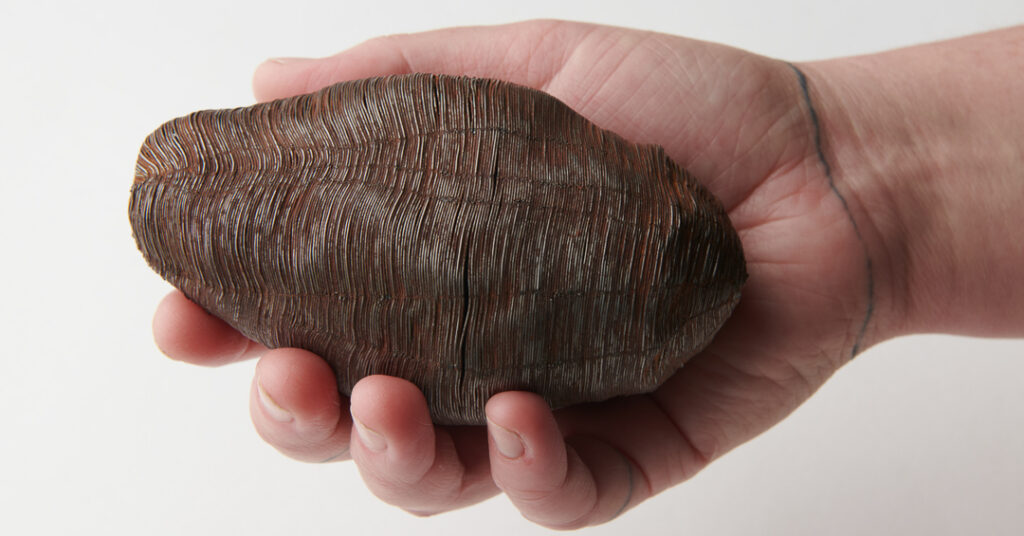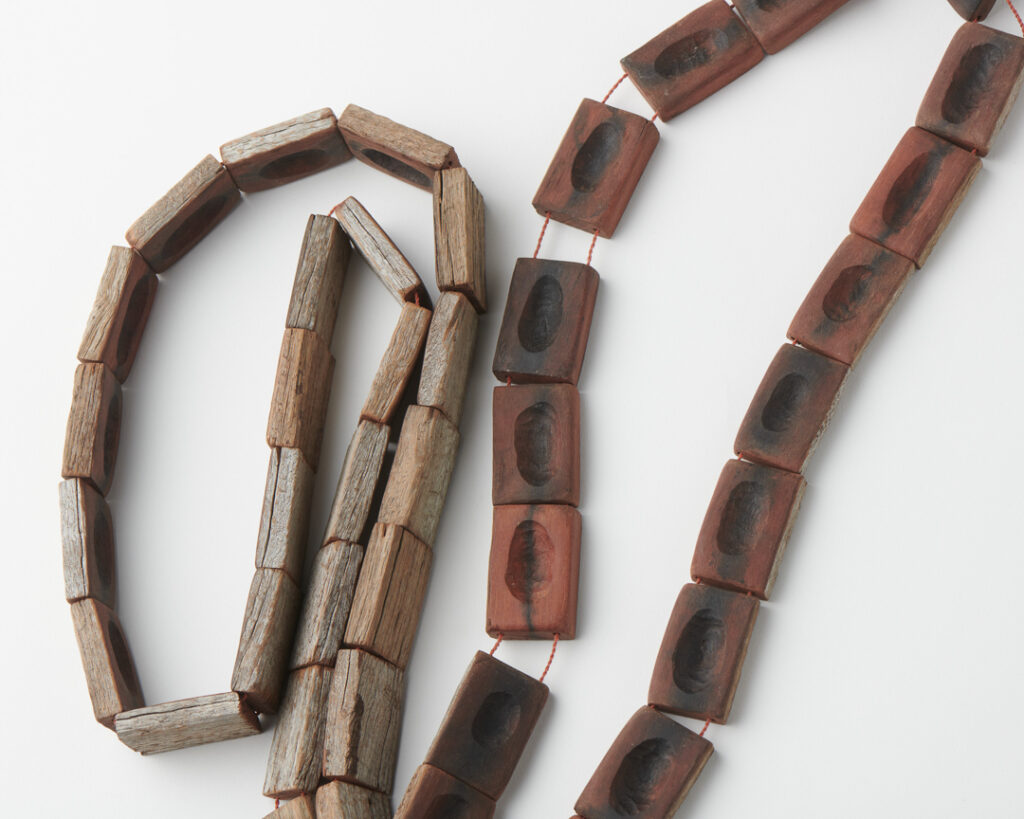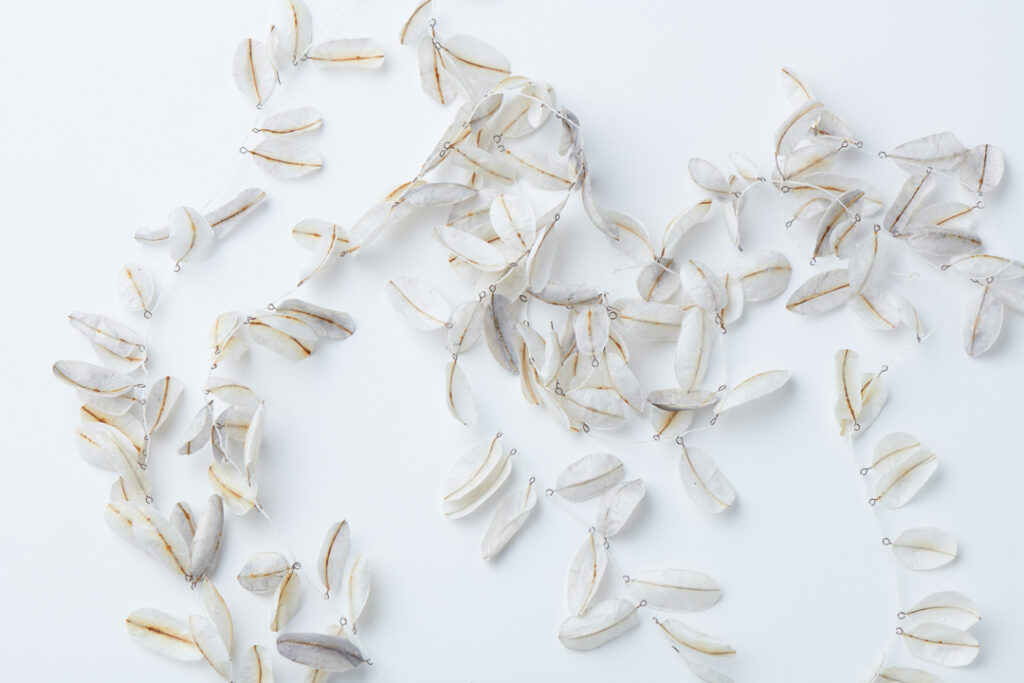Cara Johnson talks to Ilka White about a jewellery practice that is in dialogue with the settler and natural worlds that she inhabits.
A conversation between Ilka White and Cara Johnson on the occasion of Cara’s exhibition Semblance of Repair, recorded at Funaki on 5 December 2022
IW: It feels like your work is about human relationship with the rest of the world and the tensions involved in that, particularly in a settler culture.
CJ: Definitely.
IW: The questions you’re asking through this work about human intervention and the natural world are so thoughtful. And more than thoughtful, the work’s very felt and visceral. Everything is considered; it has time behind it and grows out of personal experience. The grief is palpable and it can only be that way: if you’re connected, if you’re not blocking stuff out, if you’ve got a mind and a body that’s receptive, then you have to deal with the grief and the conflicts and the ambiguities and the discomfort.
CJ: That tension is where I try and make from. It’s this point of being unsure, but knowing something is snagging, jarring with me. I try to think about the word ‘unknowing’ a lot and making through that. I don’t want any conclusions to come through the work, it’s just making through that unknowing. Sensing that there’s some sort of conflict and tension that seems significant enough to make a work about.
IW: ‘Unknowing’ is a nice word, or proposition. I think that’s where I came to in thinking about the work being very felt, or visceral. The enquiry is not intellectual. Western colonising cultures put emphasis on the intellect and the mind working, but there’s such a beauty and wisdom in being rather than thinking. That tension – I mean, I don’t enjoy tension – but I’m appreciative of your patience or your willingness to dwell in it, to sit with it. Can you tell me about how that feels?
CJ: I’m trying to deal with it through artwork, I guess. And I’m trying to not just focus on grief. Grief is a big part of my practice, but by doing things that are very slow and very time consuming, and by using materials that are kind of waste or weed species, I’m trying to honour materials through time. That’s a hopeful thing to do and a worthwhile thing to do – to sit with materials and try and draw value back into them. I don’t know how we deal with grief but making through it is one way I try.
IW: It makes me think of the adage “action is the antidote to despair”. I know that your action is broader than your artwork. I know you’re president of the East Otway Landcare Group. Sometimes I feel like artwork is a waste or a folly, given the situation we’re in and the limited time we have left, to save a lot of what’s dear. I completely understand the power of art to point to what needs to happen, but sometimes I fall into thinking, “well, it needs to happen so quickly, we haven’t got time to make subtle work about it”. But then when I come back to your work, I feel like change needs to happen on so many levels. Our action takes different forms. There’s the very basic, practical level of getting more trees in the ground when there’s been such clearing, and then there’s the sort of spiritual level, of resistance, of resilience – resistance to the dominant culture of consumerism and destruction, and resilience in the face of it.
CJ: I understand that you mean about artwork perhaps being seen as a folly at this point in human history, but it still feels relevant to me and even just as a person, a human, it makes my life feel worthwhile. It doesn’t feel like wasted time. The more I make artworks that are about the things that are most important to me, the louder I’m saying “this is important” – but in a quiet way, if that makes sense. We all live our lives in ways that align with the things that are most important to us and artwork is just one way of me trying to exist in a way that makes sense.
IW: It absolutely makes sense, and the reading that I just brought to it is another example of this problematic habit, whether it’s Western or simply modern, of categorising: this is art, that is Landcare.
CJ: I was chatting with [fellow artist] Inari Kiuru recently and I was saying that I came to a realisation a couple of years ago that it’s not art practice and then this, and this, and this, it’s just life and it all overlaps.
IW: I love the way your work helps me think about these notions of categorisation, boundaries, human/natural world interactions. Under all of it is this recognition of interconnection. And there are questions about invader cultures – both human and plant – and colonising species, pioneer species, what they do and the benefit of a plant that heals land, even if it wasn’t the one that grew there originally. It also brings up the fact that this country has always been managed. Who decides what management is wise and what’s not?
CJ: I practice a lot of weed control in my day-to-day life, and a lot of my works are coming from that. So, killing a plant but also being unsure if this is the best approach – is this what I should be doing? I use weed species in my work very deliberately. A lot of the time they’re not very nice to work with. In particular, the English broom in Paddock I; it splintered and fractured a lot when I was cutting it. In Apple sapling I used an apple tree, and the Verdant series are made from a willow tree that I killed. And I worked with blackberry in Taking measures. But I’m not just using them because they’re an invasive species that threatens habitat and biodiversity. I’m also using them as a symbol – even though this plant wasn’t meant to grow here, it still has value, it’s still a plant. By giving it my time, I’m honouring it in a way, respecting it, acknowledging its existence. That’s something I’m working through.
IW: The forms, like your casting of a clump of soil, make me think of monuments that we erect. Oftentimes they carry so much sadness, because they’re memorials to what’s not there anymore… just a trace of the original subject. The poetics of that, Cara – the soil washing out from the inside. Soil is everything.
CJ: That piece (38°22’37″S 144°15’53″E (a handful of dirt) took me a long time. I spent a lot of time holding this clump of dirt. I packed it with water, so it held together as one piece. Holding it in my hands and spending that time with it, it became familiar, every little contour. I became more invested in making this artwork to honour that dirt. Whenever I set out to make a piece, I think ‘oh, this one won’t take that long, this’ll be the one that I can quickly do’ and then it stretches out and stretches out… but that dedication of time – always a lot longer than I anticipate – is important, because I really want to invest myself in the piece, and giving time to something is a way that you can put yourself into it. I like the idea of making things that are very fragile and take a long time. For me, the thought and the time are the most important elements of the things I make. I soaked the soil out and returned it to the spot that I collected it from. I guess this was quite a big shift for me. I realised that whenever I made a work, I wanted to try and value a thing outside of the work, so not make the work of value, but the thing that it refers to.
IW: There’s also your very honed attention to the way materials speak, the associations that they carry. Your choice of material is not random. You know that every material holds associations. They mean one thing for you, but every person coming to your work will have different life experience and different stories…
CJ: …that they bring to it, yes. Which I really like. Like all artists, my work’s deeply personal and is drawn from what I know; what I think I know – or don’t know. But I select materials very deliberately. I don’t go for a walk and think “ooh!”. I think, I want to use tree guards because tree guards are so complicated and to me, they’re such a symbol of where we are at this point, with trying to fix degraded land. So I use tree guards because of what they’re already holding when I come to them. The same goes for materials like old fence posts and baling twine, and all these materials that connect to agriculture. There are clear links in Australia between farming and land clearing.
“my brain and my heart constantly return to an older way of being on this planet”
IW: That human impact on land… my brain and my heart constantly return to an older way of being on this planet, this continent in particular. Your work reminds me of that over and over. It’s reflecting on settler culture but there’s always the presence of the alternative, of First Nations culture and its comparison as a beautiful, eerie almost, presence.
CJ: While I always try and speak from my perspective, that’s an undercurrent in my thinking. On boundaries: I live next door to a farm. Our neighbours are our friends and they’re great people, but if one of my chooks flies over the fence, I feel a bit uneasy jumping over. It’s a one hundred acre property, but I still feel like I can’t cross that boundary. It’s so ingrained in me – that’s their fence line, and that idea of boundaries is also something I’m stuck on.
IW: The plants don’t care.
CJ: They certainly don’t!
IW: The birds don’t care. The wattle bird in my garden doesn’t care if it nests in a lemon tree. Native bees love lavender, mint, sage, thyme, all these exotic plants. Is it just a human to be asking ‘whose is this?’
CJ: It’s all about control.
IW: Yes. I’m also thinking about the beauty of this work made from a fence post, Cast back I. The carved sections were originally about dams, the holes that were dug on country. But as you worked, and given all the time spent, the depressions began to feel more like your fingerprint, your imprint. So it’s still about human imprint isn’t it?
CJ: Yes, and it’s about holding something too tightly.
IW: So there’s that tension again. But then the following work, Cast back II – has lighter, more ephemeral impressions, taken from Cast back I – there’s this repetition of presence, absence. I love your material literacy in the use of wood and paper making, thinking about trees – the original source of these materials.
CJ: Sometimes I think I’m a bit too literal, but I like clear connections.
- Cara Johnson, Verdant I, 2022, willow, found silage wrap, found baling twine. Photos: Fred Kroh.
- Cara Johnson, Tether II, 2021, found tree guard, iron. Photo: Anita Beaney
IW: Tell me about the colour you’ve added to the three Verdant necklaces, because these works are quite different to many of the others which are used in their found state. Even if you’ve carved the bark off something, or manipulated it into another form, or cast it, you generally haven’t applied something – you’ve usually taken something away.
CJ: These are the newest works in the exhibition. I’ve been thinking about this idea of new colours, these colours that have become part of what we see, particularly in a rural landscape. They’re the colours of tree guards and baling twine and silage wrap. These necklaces are made of willow that I’ve harvested, but I’ve painted them to refer to these new landscape colours.
IW: To come back to the sitting with discomfort, I find myself uncomfortable with those colours. Partly it’s recognising your material, because I know silage wrap, and I know how scratchy and horrible it is as I have spun with it as well.
CJ: I’ve never met anyone else who worked with silage wrap and baling twine, except for you, Ilka! When I’m making the string from baling twine, sometimes I lose the skin from my fingers – it’s horrible stuff, really fibrous.
IW: It really is. And even the way, in the central piece, Verdant II, the resulting spun twine – which is very different and much more beautiful thing than the way that it comes on a bale – it almost feels as though it’s strangling that wood, like the way the tree guard strangles the tree… those themes, they keep recurring.
CJ: This happens often, but I’ll think I’ve got a completely new idea and I’ll make and make and make, and then I’ll finish it and go, ‘oh, I think I did that in a different way already’.
IW: Somebody said an artist just makes the same work over and over.
CJ: Maybe. Maybe it’s just slightly different iterations and that’s still worthwhile, it just shifts a little bit.
IW: I know that experience very personally as well. When I’m asked what it’s about, it always comes back to the same root. And there’s that same map of associations in the method, not just the materials. The spinning – I can’t see handmade string without thinking of the age of that skill and how key it is in human evolution.
CJ: I don’t think there’d be many cultures that it wouldn’t connect to. I sort of see the string making as an afterthought – “oh, I think I need to make string for that piece” – and two days later I’ll still be making string and I think, “oh my god, I forgot how long this takes!”
IW: Do you sit for long periods, or do you do a little bit here and there amongst other tasks?
CJ: I used to sit for very long periods and then I had a baby, so I do a lot of making at night now because I don’t like being away from her. I’m a bit of a night owl. I’ll make on the train, or with my dinner next to me, I’ll be making string. I often sit in the car and make string. For most of my work, I don’t need many tools. I use some wood carving tools and they’re very portable, so I can make in different spots and it’s very domestic and it does connect to things like cooking, doing house jobs, the garden.
IW: Your actual crafting, spinning and so on, feels like the tip of an iceberg. There’s the walking on country, the planting, the Landcare work. What proportion of your time is spent on making?
CJ: I’d say the creative part of my life, the creative output, maybe a third of it is physical making but a really big part of my practice is taking photos. I find photography helps me capture the essence of something I’d like to translate into a work or works. Photography can almost distil an idea that I can then draw from. I also do a lot of drawing and writing. I’ll often walk off into the bush across the road and sit and write. Once I’ve decided on a material that I want to use, then I’m actively seeking that out. Then I’m collecting baling twine that I find snagged on fences. I also find a lot of silage wrap, silage net, in tangles on the side of the road. And tree guards I find, in the undergrowth or in a creek. I’m always collecting these materials, but I guess my practice is a swirl of all these things interacting with each other, and the making is the end result.
IW: A natural analogy again is the roots, so all of this happens [underground] like mycelium and we just see this little fruiting body.
CJ: Yes, this is the mushroom.
IW: Glory be.
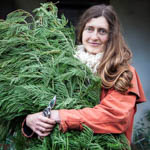
Ilka White is an artist whose practice spans textiles, teaching, cross-disciplinary collaboration and art-in-community. Her work reflects the principles of sustainability and often responds to the forces at play within the natural world. An abiding interest in world textile traditions also informs many aspects of Ilka’s making and teaching practice. Follow @ilkawhite
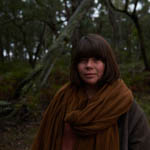
Cara Johnson’s craft-based practice interrogates tensions and narratives connected to the ways land is treated and used through material, intention and invested labour. She is a current PhD Candidate and sessional lecturer in RMITs School of Art. Cara’s works are held in various private and public collections including the National Gallery of Victoria. Her exhibition Semblance of Repair took place at Funaki from 30 November to 23 December 2022. Follow @cara__johnson
